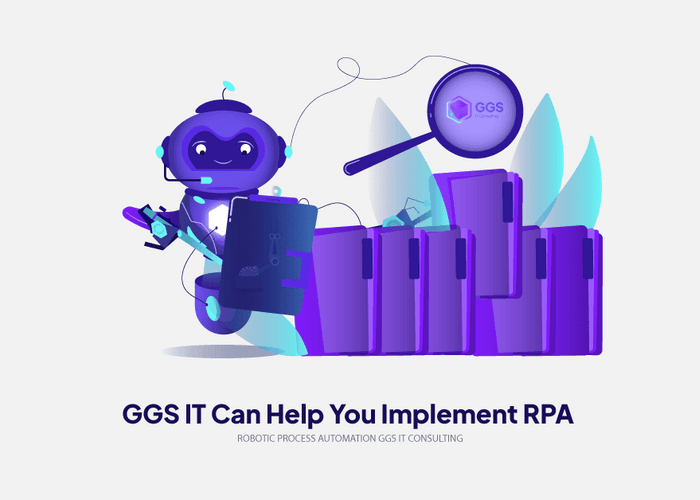Business Process AutomationLearn more
What is robotic process automation (RPA)?

Saving time and money are among the most important benefits that robotic process automation can bring to a company. As one of the types of process automation that uses software robots to do repetitive and error-prone tasks, it requires good planning to achieve optimal results. When working with our clients, we help them in implementing robotic process automation software, from strategic planning, through process mapping, bot building, and delivery. We know from experience that it takes more than investing in the right tools to implement RPA. First, you need to understand what RPA is and how it works.
What is a business process?
To answer what robotic process automation is, we first need to look at the business process itself. A business process is a series of interrelated activities and tasks, carried out in a specific order, according to specific rules and structure.
Their performance serves a specific purpose and is intended to produce a specific result. The American Productivity Quality Center (APQC) divides business processes into operational processes, meaning key processes for the company, and supporting processes, which are to support the implementation of the key processes.
Operational processes include:
- developing the company’s vision and strategy,
- developing and managing products and services,
- marketing and selling products and services,
- procurement,
- creation, and delivery of products and services,
- as well as customer service management.
The supporting processes include:
- organization and human capital management,
- information technology management,
- financial resources management,
- property management,
- environmental protection and occupational safety,
- external relations management
- and knowledge improvement.
Some of these processes can be automated and robotized (for advice on how to identify them look at our article - 10 business processes you can automate using Robotic Process Automation (RPA).
What does "robotic process automation" mean?

Robotic process automation in business is a type of process automation that takes place through the use of robots. RPA saves time for employees who are replaced by robots for repetitive routine tasks and can concentrate on more creative, relevant, and creative areas of the business.
Appropriately programmed robots interface with computer applications to:
- carry out repetitive, rule-based tasks,
- perform calculations,
- and execute decisions.
Robotic process automation is used in a wide range of industries, from IT, finance, and commerce to telecommunications, office administration, logistics, manufacturing, and tourism.
What is robotic process automation (RPA)?

Robotic Process Automation (RPA) is quickly gaining ground in business, as it now allows tasks, which used to be handled by employees for many hours, to be reduced to automated processes that take much less time.
But what is RPA, exactly? RPA means tools for building software bots used to automate repetitive, time-consuming, and error-prone activities. RPA works at the graphical user interface (GIU) to mimic human labor.
Automation is carried out through dedicated software bots that have been programmed to perform specific tasks according to rules and commands previously written in a computer program and can therefore replace human labor and deal with repetitive, serial actions.
The potential for RPA is endless, as increasing use is being made of AI, with companies utilizing robots to automate both front-office and back-office tasks.
Robots help fill out records and documents and can be used to:
- send automatic notifications,
- make schedule entries,
- transfer data between systems,
- create documents,
- as well as for reporting, controlling or ensuring data compliance.
The implementation of RPA requires preparation. Before deciding to replace human workers with bots, it is important to analyze the development model and the areas where RPA will optimize costs and working time and deliver the desired business results. From a technical point of view, implementing RPA requires appropriate technology and IT systems integration. In turn, this means capital expenditure. So, before you go for full-on RPA in your company, you should analyze the ownership costs of RPA tools.
What are the benefits of robotic process automation?

With the use of robotic process automation software, tasks that are carried out in the company schematically and cyclically can be automated, which saves not only time but also money.
Many business processes require the use of various applications and systems, therefore implementing RPA is often the best solution - robots operating at the user interface level do not require a large amount of programming work to implement.
The most frequently mentioned benefits of robotic process automation are:
- increase in accuracy and almost complete elimination of the so-called "human error",
- shorter process completion time and the ability to work 24/7,
- identification and elimination of bottlenecks in processes,
- freeing up human resources by automating repetitive tasks,
- the ability to process large amounts of data and implement numerous processes at the same time,
- cost reduction, return on investment observed just a few months after implementation,
increasing efficiency without the need to change IT systems,
- a greater level of control with to the ability to plan and monitor each step of the robots work,
limited technical requirements, high flexibility in the configuration without programming skills.
The origins of robotic process automation (RPA)

IT industry experts have no doubt that (robotic) automation of business processes will revolutionize not only the labor market but also the entire economy. However, to understand the mechanics of business process automation, it is helpful to look at the origins of RPA.
The first buzzwords relating to business process automation appeared in print in the 1920s, when the term “workflow automation” came into use. At the time, “workflow” was understood as the flow of information between employees and departments involved in a business process. In the 1950s, the concept of “artificial intelligence” became known as the ability of computer systems to carry out human tasks without human supervision; with this also came “machine learning” understood as the practical implementation of software and algorithms used in the field of artificial intelligence.
The beginnings of Robotic Process Automation in business and technology go back to the 1990s. Then, the “screen scraper” program was introduced to facilitate database scanning for data, including statistical data, from programs, websites and documents in order to extract the desired information. That was a huge step towards RPA. Another came with workflow automation.
The first simple RPA tools were used to automate uncomplicated but tedious manual activities, and the reason for this was the realization of how much time was being wasted by employees on doing boring, repetitive activities that quickly numb the mind and take motivation away, leading to errors. The first industry to give RPA a try was business outsourcing.
Since then, the RPA market has expanded into more industries, and the RPA capabilities that were still limited in the late 1990s are today powered to an increasing extent and on a growing scale by “artificial intelligence”. The RPA market is now worth a billion dollars, with projections of seven billion dollars in five years’ time. Also, companies that invest in automation processes can rest assured that the ROI on RPA tools will be from 30 to 200 percent in the first year.
Wondering if you can automate your company's processes? Contact us for 30 minute, free consultation, and we will tell you whether this solution can help your business grow.
Related articles about robotic process automation (RPA)
We invite you to read our articles related to planning and implementing robotic process automation software in companies:
Robotic process automation consulting. How to find and choose the best experts.
Implementation of Robotic Process Automation- step by step.
10 business processes you can automate using Robotic Process Automation (RPA).
